
STRAIGHT AND LEVEL
Jim Walker and American Junior
by Bill Winter
Manufacturer, a great competitor, inventor and master showman, the late Jim Walker left us much to ponder.
 JIM WALKER was the greatest. Since he left us, model aviation has never been the same. He brought to this hobby, and business, an unbelievable combination of soaring ideas and ideals, manufactured products of un-surpassed ingenuity, and a spectacular showmanship that left us all agog. He was a Gulliver among Lilliputians. With him ended a golden era. But, what he did still touches us all.
JIM WALKER was the greatest. Since he left us, model aviation has never been the same. He brought to this hobby, and business, an unbelievable combination of soaring ideas and ideals, manufactured products of un-surpassed ingenuity, and a spectacular showmanship that left us all agog. He was a Gulliver among Lilliputians. With him ended a golden era. But, what he did still touches us all.
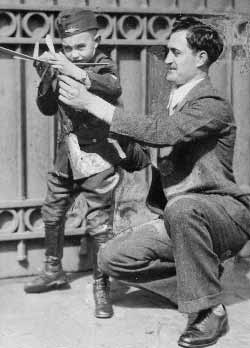 He was many things. The best salesman model aviation ever had. A major manufacturer whose ingenuity and imagineering held others in awe. He was a prolific in-ventor. A fantastic showman. A legend in his own time. Blessed with an almost superhuman coordination, he did things with model airplanes that no one ever did before, or since. He was a hero to the kids. A Pied Piper for all of us — though he led us always to bright places. He was the circus come to town. The catalyst that ignited a Nationals. A magician who held us spell-bound. And, may-be, a bit of a lovable ham. He upstaged everybody. Wild and wonderful things always happened when you were with him. As a lone tree draws lightning, he attracted the darndest adventures.
He was many things. The best salesman model aviation ever had. A major manufacturer whose ingenuity and imagineering held others in awe. He was a prolific in-ventor. A fantastic showman. A legend in his own time. Blessed with an almost superhuman coordination, he did things with model airplanes that no one ever did before, or since. He was a hero to the kids. A Pied Piper for all of us — though he led us always to bright places. He was the circus come to town. The catalyst that ignited a Nationals. A magician who held us spell-bound. And, may-be, a bit of a lovable ham. He upstaged everybody. Wild and wonderful things always happened when you were with him. As a lone tree draws lightning, he attracted the darndest adventures.
Many remember him for his three-at-once control-line act and his Sabre Dance. Others for his wins of the R/C event at the Nats, both before and after the war. The U-Reely handle was his — it came out over 20 years ago! The Interceptor folding-wing catapult gliders—the Army even used them for target practice — and the Hornet ROG. The Ceiling Walker, balloon tanks. The Fire-ball (on floats, too!), the Firebaby. He wasn't just first with many things — he was there for a generation before others caught up. Many never did.
Genius, expert competitor, manufacturer, an inspiration for kids, inventor, he was everything. Whatever you were, he was too. But mostly he was a flamboyant show-man whose knack for turning people on would be the envy of the best public relations man in any field. A modern-day Barnum, he substituted the word "hobbyist" for "sucker." A hobbyist was born every minute and Walker was out to sign 'em up.
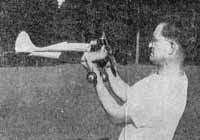 We first met this cosmic force of a man in New York shortly before the war. He had come to demonstrate in a hall, his U-control Fireball. None of us knew what he was talking about. We came, we saw, but we were not conquered. Jim had rigged a double set of lines so he could instruct the press in flying this strange on-wires airplane. A brick on a string — and that's what all the free-flighters said at the next Nats when he demonstrated it at Chicago. He flew, and flew, and flew — all day, every day. And they watched with deadpan faces. It was this very magazine, come to think of it, which then published U-control scale model plans — and the always interested scale fans (who make the world go around, and don't kid yourself) took to the idea like pigs to mud. The model airplane world was turned completely upside down.
We first met this cosmic force of a man in New York shortly before the war. He had come to demonstrate in a hall, his U-control Fireball. None of us knew what he was talking about. We came, we saw, but we were not conquered. Jim had rigged a double set of lines so he could instruct the press in flying this strange on-wires airplane. A brick on a string — and that's what all the free-flighters said at the next Nats when he demonstrated it at Chicago. He flew, and flew, and flew — all day, every day. And they watched with deadpan faces. It was this very magazine, come to think of it, which then published U-control scale model plans — and the always interested scale fans (who make the world go around, and don't kid yourself) took to the idea like pigs to mud. The model airplane world was turned completely upside down.
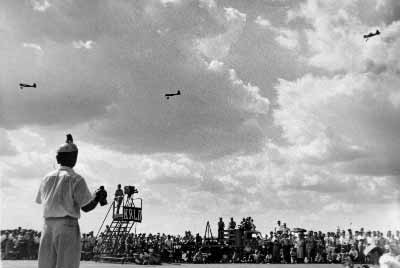 By the time of the first Olathe Nats (this year is a 20th anniversary), Jim had perfected his three-at-once act for the Sunday demonstrations. We all went home remem-bering Walker, rather than the Blue Angels! He had three McCoy 29-powered Fireballs, sitting there with engines throbbing—like the start of a team race. Waiting on the helpers to get all mills tuned, Jim would stand ex-pectantly in the center of the circle, a helmet on his head. In each hand he held a U-Reely. The third ship's lines ran to a pylon on his helmet. Its motor-control button was clenched in his teeth. All three had two-speed ignition; he flew tight formation without a slip. Eventually, he added a PA deal in his helmet and would explain what was going on as all three ships zipped around like angry bugs, motors zinging up and down to keep position. (It was rumored much later that he managed four ships simultaneously!)
By the time of the first Olathe Nats (this year is a 20th anniversary), Jim had perfected his three-at-once act for the Sunday demonstrations. We all went home remem-bering Walker, rather than the Blue Angels! He had three McCoy 29-powered Fireballs, sitting there with engines throbbing—like the start of a team race. Waiting on the helpers to get all mills tuned, Jim would stand ex-pectantly in the center of the circle, a helmet on his head. In each hand he held a U-Reely. The third ship's lines ran to a pylon on his helmet. Its motor-control button was clenched in his teeth. All three had two-speed ignition; he flew tight formation without a slip. Eventually, he added a PA deal in his helmet and would explain what was going on as all three ships zipped around like angry bugs, motors zinging up and down to keep position. (It was rumored much later that he managed four ships simultaneously!)
He was in demand at sportsman shows. By now he really had an act. The star attraction was his radio-control lawnmower. This thing had gotten national publicity in popular-science type magazines — with Jim in a hammock, sipping a glass, while buddy mower ran up and down the lawn. Millions laughed. The mower, incidentally, was rendered reeless later, a practical concession after he had followed horses in a Seattle parade. (Jim was fond of telling about the guy standing on a theater marque who laughed so hard he fell off and broke a leg.)
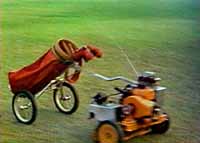 Before a crowded house at the Sportsman's Pier in Chicago, Jim made his grand entrance, followed by the docile mower. A control switch was hidden in his belt buckle. Off to the side of the tanbark ring stood the three orange-colored Fireballs. Bowing and gesturing, Jim strode toward center-circle. Unknowingly, he hit the control switch. The jealous mower took off on its own, sneaked up on the defenseless Fireballs and spewed forth a cloud of orange dust. It brought down the house. The crowd kept roaring, "Encore, encore."
Before a crowded house at the Sportsman's Pier in Chicago, Jim made his grand entrance, followed by the docile mower. A control switch was hidden in his belt buckle. Off to the side of the tanbark ring stood the three orange-colored Fireballs. Bowing and gesturing, Jim strode toward center-circle. Unknowingly, he hit the control switch. The jealous mower took off on its own, sneaked up on the defenseless Fireballs and spewed forth a cloud of orange dust. It brought down the house. The crowd kept roaring, "Encore, encore."
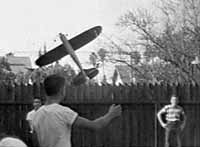 Jim played a U-Reely handle like Al Hirt tootles a trumpet. A virtuoso. For his Sabre Dance his two-speed ignition Fireball, with a pin on its tail, would go into an abrupt climb, hover motionless, then back down slowly to burst a balloon on the ground. A quick recovery climb and the Fireball circled in level flight while Jim took the applause.
Jim played a U-Reely handle like Al Hirt tootles a trumpet. A virtuoso. For his Sabre Dance his two-speed ignition Fireball, with a pin on its tail, would go into an abrupt climb, hover motionless, then back down slowly to burst a balloon on the ground. A quick recovery climb and the Fireball circled in level flight while Jim took the applause.
Or he would run out from a side-line crowd at the Nats — this happened in Minneapolis, if memory serves, when Jim had been banned as a distraction to the crowd who ate up his antics — a Fireball, engine running, right at his finger tips. As he went, he'd pay out lines to steal the show. If the wind was light, he'd let out 200 feet of lines. The sight of a Fireball almost free-flighting around a 400-foot circle is something no one could forget. Jim, incidentally, kept his radio frequency secret because we all loved to louse up his mower act with clandestine handheld transmitters. With the mower marching around him like a crack drill team, passing between his feet, and stuff, it was no time for such monkey-shines! Poor Jim never knew what hap-pened but he'd stare us through and through!
During that early New York visit, he dragged the Polk brothers from their shop to see the Fireball fly. Conveniently at hand was the block-long post office on the city's west side. Nothing would do him but to fly in front of the steps. The crowd was immense. Buses stopped. Cars stopped. Nobody could move. Out came the Emergency Squad in special trucks and flashing red lights and deafening klaxon horns. When the same thing happened in Chicago, Jim was insulted when only one cop on a motorcycle was dispatched. Jim got even by handing the lines to the cop. Not being told to pivot with the model, the man was soon tied up by steel wires.
 Jim had an unbelievable mastery of models. For him they'd do everything but talk. Once, going into a buyer's office, he noted an open window on each side of the desk in the comer. So he tossed a glider out of one window just before shaking hands. The obedient bit of sheet balsa circled around the corner of the building, came in the other window, and back to Jim's hand. What buyer would say, "No" after that? Jim could toss gliders with an infinite variety of motions, backhand, around his back, a kind of upside-down, upward flip, to the right, to the left, anywhere. And the dam things always came to roost in his hand.
Jim had an unbelievable mastery of models. For him they'd do everything but talk. Once, going into a buyer's office, he noted an open window on each side of the desk in the comer. So he tossed a glider out of one window just before shaking hands. The obedient bit of sheet balsa circled around the corner of the building, came in the other window, and back to Jim's hand. What buyer would say, "No" after that? Jim could toss gliders with an infinite variety of motions, backhand, around his back, a kind of upside-down, upward flip, to the right, to the left, anywhere. And the dam things always came to roost in his hand.
He had a barrel of tricks. A little knick in the prop permitted Ilim to catch the wound-up prop in the wire landing gear. He casually would hand-glide the model. When it struck the floor, the prop would spring free, and the ship would power-circle around the group - totally ignored by its pilot. He had the Ceiling Walker- in fact, it was a bust, and he ended up with a warehouse full of the things. It was just a stick with a prop on top and another on the bottom. It would bore straight up to the top of a ten-floor building. He'd hand these things out in any large city street, and soon dozens of the copters would be sailing on high. He did this in New York one day, summoned us down by his car phone—as well as the entranced buyer from swank Abercrombie and Fitch.
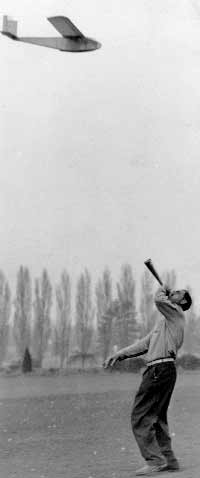 There was a night parade up Broadway. It so happened—as it always seemed to happen — that Jim was on hand. He slipped the searchlight operator a fiver to follow his Interceptor gliders in flight. As the caravan went through Times Square, the crowd was treated to a rapid-fire launching of gliders high into the sky. Walker never missed a chance to show model planes to the public.
There was a night parade up Broadway. It so happened—as it always seemed to happen — that Jim was on hand. He slipped the searchlight operator a fiver to follow his Interceptor gliders in flight. As the caravan went through Times Square, the crowd was treated to a rapid-fire launching of gliders high into the sky. Walker never missed a chance to show model planes to the public.
He invented a sound-control glider. This creation had a diaphragm built into its side. Jim ran beneath tooting on a horn, steering the thing about like any R/C rudder job. Behind the project was a vast amount of trial-and-error research. Testing response of the "receiver" to various sounds, Jim walked out of his house one night, and down the street. He was loaded down with noise-making devices — including whistles, a drum (to hear him tell it), and even a revolver. When he fired the gun in an empty lot, the nervous neighbors called the cops. Climbing out of the cruiser—it is unknown what effect the siren had upon the model back in the basement—the burly arm of the law inquired what in the name of Ned was Walker doing. Noting Jim's little pop gun, the intrigued cop dragged out his own bigger shooting iron, and in the cause of aeronautical science, emptied it into the air.
It follows that a supercharged guy like Jim would be a bundle of nerves. They were forever advising him to take up a hobby! Whatever he took up, he excelled in. His model railroad setup included a crane (so he said) which deposited him in the center of things. A golfer, he established a scientific way — another service! — of testing golf balls. A bom prankster, he pocketed extra lively pellets and, when some sharpie would spot Jim-the-duffer on a course, ready for fleecing, somehow they'd end up in this driving match — must we go on?
He'd give away his shirt. He loved kids and they loved him. He'd stop his station wagon, loaded with ready-to-fly Firebaby's, put on an act, catch the crowd, and then offer one free to anyone who would start the engine. He was true to his word and would hand out dozens, if not hundreds.
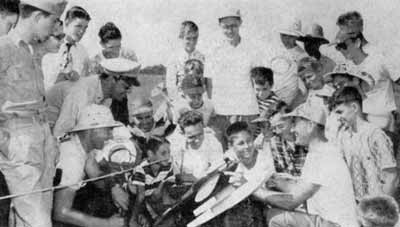 He'd gimmick anything. A simple wire mechanism on his demonstration Ceiling Walker allowed the copter to strike the ceiling, where the props would stop driving, allowing the thing to sink vertically to the floor. On striking the floor, the props would release and power it back to the ceiling. Up and down, up and down. If you were working at a bench in the hangar at the Nats, he would slip these jobs under the bench where it bounce up and down.
He'd gimmick anything. A simple wire mechanism on his demonstration Ceiling Walker allowed the copter to strike the ceiling, where the props would stop driving, allowing the thing to sink vertically to the floor. On striking the floor, the props would release and power it back to the ceiling. Up and down, up and down. If you were working at a bench in the hangar at the Nats, he would slip these jobs under the bench where it bounce up and down.
He won radio at the Nats- several times we think.Before the war he flew a modern-looking trike gear ship--the first--which taxied out, maneuvered on the ground, took off and looped. Once, when Jimmy Slagle (the phenomenal bare-foot kid of the Wichita Nats ) was practicing at the Minneapolis Nats, he and Jim fell to topping each other. Jim had his Fireball-which is not supposed to be a stunt ship. So Jim finally said "try this," and executed a perfect step stairs climb to a higher altitude.And, you have trouble with those ccorners on a square?
 Jim was impatient with us all.. None of us ever did enough! Back before AMA set up programs to get teams to world championships, the Wakefielders begged every red penny in sight. At one hobby industry convention in Chicago, Ed Lidgard made a pitch for money to get the Wakefielders overseas. The silence was deafening. Up popped Jim who announced, "You guys make me sick: here's $5,000 for them!" And that's how they got to Europe that year. If he liked you, you'd get a surprise carton every year, loaded with kits and ready -to -fly things of all descriptions. Out to convert the world to model airplane flying, he was pretty well on the way when he abruptly left us.
Jim was impatient with us all.. None of us ever did enough! Back before AMA set up programs to get teams to world championships, the Wakefielders begged every red penny in sight. At one hobby industry convention in Chicago, Ed Lidgard made a pitch for money to get the Wakefielders overseas. The silence was deafening. Up popped Jim who announced, "You guys make me sick: here's $5,000 for them!" And that's how they got to Europe that year. If he liked you, you'd get a surprise carton every year, loaded with kits and ready -to -fly things of all descriptions. Out to convert the world to model airplane flying, he was pretty well on the way when he abruptly left us.
It fell to us to write Jim's obit. Ending it, we had said that, "You knew him, too. Every time you pick up a U-control handle, you will think of Jim Walker." There's a letter this month in "You said it," which remarks that Jim Walker would turn over in his grave if he saw what had been done to model aviation. Jim surely would.
There are no giants these days in our hobby. Competition is so diversified that the days of individual stars- the Walkers,the Kordas, the Grants, the Goldbergs,- are gone forever. But we shall never run out of the great things Walker left us. He'd put back the fun in model aviation.
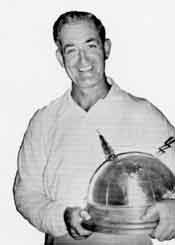 We would all do well to remember such a man.We badly need another. Has God destroyed the mold?
We would all do well to remember such a man.We badly need another. Has God destroyed the mold?
Written by Bill Winter, Editor of American Aircraft Modeler magazine.
This story appeared in his "Straight and Level" column in the November 1968 issue.
Note, Bill is also now deceased.
Return to A-J Classics Home page
Home | Jim Walker | FireWire | Air Mail | Workshop | Short Takes | Fireball | Firebaby